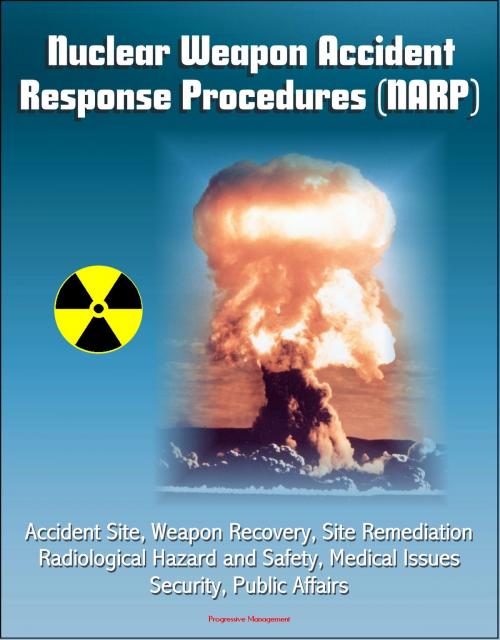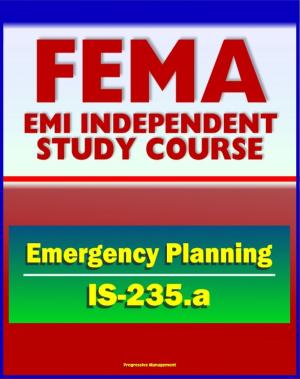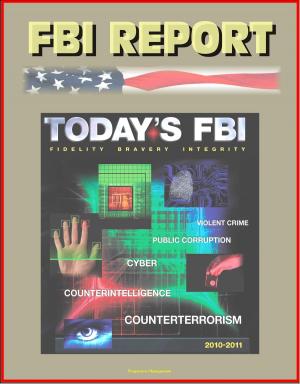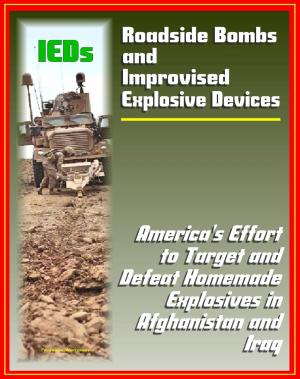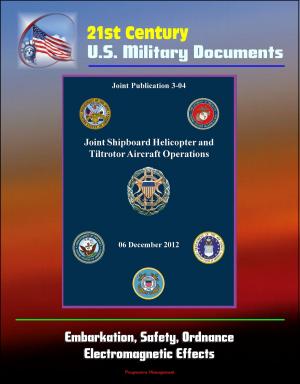Nuclear Weapon Accident Response Procedures (NARP) - Accident Site, Weapon Recovery, Site Remediation, Radiological Hazard and Safety, Medical Issues, Security, Public Affairs
Nonfiction, History, Military, Nuclear Warfare| Author: | Progressive Management | ISBN: | 9781301773534 |
| Publisher: | Progressive Management | Publication: | September 21, 2012 |
| Imprint: | Smashwords Edition | Language: | English |
| Author: | Progressive Management |
| ISBN: | 9781301773534 |
| Publisher: | Progressive Management |
| Publication: | September 21, 2012 |
| Imprint: | Smashwords Edition |
| Language: | English |
This Manual provides a concept of operations as well as functional information necessary to execute a comprehensive and unified response to a nuclear weapon accident. It provides information for planners and response elements to understand the overall response concept and roles the Department of Defense (DoD) and the Department of Energy/National Nuclear Security Administration (DOE/NNSA) assume as both Lead Federal Agency (LFA) and as a coordinating or cooperating agency under the NRP.
This Manual assumes that a radiological release has occurred because of a nuclear weapon accident and that consequence management operations are required. This edition of this Manual also provides information on site remediation (SR) activities after an accident involving a nuclear weapon. It does not detail all aspects of SR, but it does define a process by which response organizations may effectively face the challenge of SR. Crisis response operations to respond to a terrorist attack on a U.S. weapon are not addressed in this Manual.
This Manual provides a model response organization reflecting the philosophy and structure used by State and local responders nationwide. It identifies publications and resources used in response efforts, describes the policies and responsibilities outlined in the publications, identifies specific radiological information available in other publications, and provides a basis for developing detailed plans tailored to each Theater of Operations and Response Task Force (RTF) area of operations.
Definitions * Abbreviations And/Or Acronyms * Chapter 1 - Introduction * Chapter 2 - Functional Response Tiers And Nuclear Weapon Accident Response Assets And Resources * Chapter 3 - U.S. Territory Nuclear Weapon Accident Response Phase I: Notification And Deployment * Chapter 4 - U.S. Territory Nuclear Weapon Accident Response Phase Ii: Initial Response * Chapter 5 - U.S. Territory Nuclear Weapon Accident Response Phase Iii: Accident Site Consolidation * Chapter 6 - U.S. Territory Nuclear Weapon Accident Response Phase Iv: Weapon Recovery Operations And Disposition * Chapter 7 - U.S. Territory Nuclear Weapon Accident Response Phase V: Site Remediation (Sr) * Chapter 8 - Shipboard Accident Response * Chapter 9 - Foreign Territory U.S. Nuclear Weapon Accident Response Concept Of Operations * Chapter 10 - Radiological Hazard And Safety Environmental Monitoring * Chapter 11 - Medical * Chapter 12 - Security * Chapter 13 - Communications * Chapter 14 - Public Affairs * Chapter 15 - Legal * Chapter 16 - Logistics Support * Chapter 17 - Training * Appendices * Ap1. Appendix 1, Shipboard Radiological Monitoring And Control * Ap2. Appendix 2, Shipboard Firefighting * Ap3. Appendix 3, Radiological Monitoring Equipment * Ap4. Appendix 4, Radioactive Materials, Characteristics, Hazards, And Health Considerations * Ap5. Appendix 5, Radiation Detection And Measurement * Ap6. Appendix 6, Area And Resource Surveys * Ap7. Appendix 7, Environmental Sampling * Ap8. Appendix 8, Bioassay Procedures * Ap9. Appendix 9, Specialized Radiological Monitoring And Hazard Assessment Capabilities * Ap10. Appendix 10, Contamination Control * Ap11. Appendix 11, Respiratory And Personnel Protection * Ap12. Appendix 12, Radiological Monitoring, Measurement, And Control Forms * Ap13. Appendix 13, Conversion Factors For Weapons Grade Plutonium (Pu) * Ap14. Appendix 14, Non-Radiological Toxic Hazards * Ap15. Appendix 15, Joint Information Center/Combined Information Bureau (Jic/Cib) Administrative, Communication, And Logistic Support And/Or Equipment * Ap16. Appendix 16, Jic/Cib Recommended Key Messages And Non-Releasable Information * Ap17. Appendix 17, Public Affairs Guidance And/Or Contingency Releases * Ap18. Appendix 18, Public Affairs Radiation Fact Sheets
This Manual provides a concept of operations as well as functional information necessary to execute a comprehensive and unified response to a nuclear weapon accident. It provides information for planners and response elements to understand the overall response concept and roles the Department of Defense (DoD) and the Department of Energy/National Nuclear Security Administration (DOE/NNSA) assume as both Lead Federal Agency (LFA) and as a coordinating or cooperating agency under the NRP.
This Manual assumes that a radiological release has occurred because of a nuclear weapon accident and that consequence management operations are required. This edition of this Manual also provides information on site remediation (SR) activities after an accident involving a nuclear weapon. It does not detail all aspects of SR, but it does define a process by which response organizations may effectively face the challenge of SR. Crisis response operations to respond to a terrorist attack on a U.S. weapon are not addressed in this Manual.
This Manual provides a model response organization reflecting the philosophy and structure used by State and local responders nationwide. It identifies publications and resources used in response efforts, describes the policies and responsibilities outlined in the publications, identifies specific radiological information available in other publications, and provides a basis for developing detailed plans tailored to each Theater of Operations and Response Task Force (RTF) area of operations.
Definitions * Abbreviations And/Or Acronyms * Chapter 1 - Introduction * Chapter 2 - Functional Response Tiers And Nuclear Weapon Accident Response Assets And Resources * Chapter 3 - U.S. Territory Nuclear Weapon Accident Response Phase I: Notification And Deployment * Chapter 4 - U.S. Territory Nuclear Weapon Accident Response Phase Ii: Initial Response * Chapter 5 - U.S. Territory Nuclear Weapon Accident Response Phase Iii: Accident Site Consolidation * Chapter 6 - U.S. Territory Nuclear Weapon Accident Response Phase Iv: Weapon Recovery Operations And Disposition * Chapter 7 - U.S. Territory Nuclear Weapon Accident Response Phase V: Site Remediation (Sr) * Chapter 8 - Shipboard Accident Response * Chapter 9 - Foreign Territory U.S. Nuclear Weapon Accident Response Concept Of Operations * Chapter 10 - Radiological Hazard And Safety Environmental Monitoring * Chapter 11 - Medical * Chapter 12 - Security * Chapter 13 - Communications * Chapter 14 - Public Affairs * Chapter 15 - Legal * Chapter 16 - Logistics Support * Chapter 17 - Training * Appendices * Ap1. Appendix 1, Shipboard Radiological Monitoring And Control * Ap2. Appendix 2, Shipboard Firefighting * Ap3. Appendix 3, Radiological Monitoring Equipment * Ap4. Appendix 4, Radioactive Materials, Characteristics, Hazards, And Health Considerations * Ap5. Appendix 5, Radiation Detection And Measurement * Ap6. Appendix 6, Area And Resource Surveys * Ap7. Appendix 7, Environmental Sampling * Ap8. Appendix 8, Bioassay Procedures * Ap9. Appendix 9, Specialized Radiological Monitoring And Hazard Assessment Capabilities * Ap10. Appendix 10, Contamination Control * Ap11. Appendix 11, Respiratory And Personnel Protection * Ap12. Appendix 12, Radiological Monitoring, Measurement, And Control Forms * Ap13. Appendix 13, Conversion Factors For Weapons Grade Plutonium (Pu) * Ap14. Appendix 14, Non-Radiological Toxic Hazards * Ap15. Appendix 15, Joint Information Center/Combined Information Bureau (Jic/Cib) Administrative, Communication, And Logistic Support And/Or Equipment * Ap16. Appendix 16, Jic/Cib Recommended Key Messages And Non-Releasable Information * Ap17. Appendix 17, Public Affairs Guidance And/Or Contingency Releases * Ap18. Appendix 18, Public Affairs Radiation Fact Sheets
